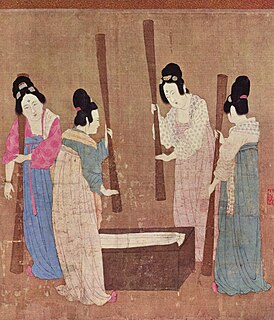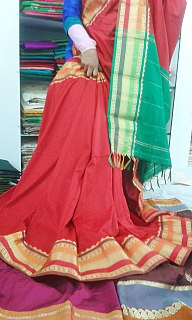Related Research Articles

Silk is a natural protein fiber, some forms of which can be woven into textiles. The protein fiber of silk is composed mainly of fibroin and is produced by certain insect larvae to form cocoons. The best-known silk is obtained from the cocoons of the larvae of the mulberry silkworm Bombyx mori reared in captivity (sericulture). The shimmering appearance of silk is due to the triangular prism-like structure of the silk fibre, which allows silk cloth to refract incoming light at different angles, thus producing different colors.

The economy of Bangladesh is a developing market economy. It's the 39th largest in the world in nominal terms, and 30th largest by purchasing power parity; it is classified among the Next Eleven emerging market middle income economies and a frontier market. In the first quarter of 2019, Bangladesh's was the world's seventh fastest growing economy with a rate of 7.3% real GDP annual growth. Dhaka and Chittagong are the principal financial centers of the country, being home to the Dhaka Stock Exchange and the Chittagong Stock Exchange. The financial sector of Bangladesh is the second largest in the Indian subcontinent. Bangladesh is one of the world's fastest growing economy.

Chittagong, officially known as Chattogram and also known as the Port City of Bangladesh, is a major coastal city and financial centre in southeastern Bangladesh. The city has a population of more than 2.5 million while the metropolitan area had a population of 4,009,423 in 2011, making it the second-largest city in the country. It is the capital of an eponymous District and Division. The city is located on the banks of the Karnaphuli River between the Chittagong Hill Tracts and the Bay of Bengal. Modern Chittagong is Bangladesh's second most significant urban center after Dhaka.

Sericulture, or silk farming, is the cultivation of silkworms to produce silk. Although there are several commercial species of silkworms, Bombyx mori is the most widely used and intensively studied silkworm. Silk was believed to have first been produced in China as early as the Neolithic Period. Sericulture has become an important cottage industry in countries such as Brazil, China, France, India, Italy, Japan, Korea, and Russia. Today, China and India are the two main producers, with more than 60% of the world's annual production.

Rajshahi is a metropolitan city, and a major urban, commercial and educational centre of Bangladesh. It is also the administrative seat of eponymous division and district. Located on the north bank of the Padma River, near the Bangladesh-India border, the city has a population of over 763,952 residents. The city is surrounded by the satellite towns of Nowhata and Katakhali, which together build an urban agglomeration of about 1 million population. Arguably Rajshahi is the most clean and green among the cities in Bangladesh.

Rajshahi District is a district in mid-western Bangladesh. It is a part of the Rajshahi Division. The metropolitan city of Rajshahi is in Rajshahi District.

Karnataka produces 9,000 metric tons of mulberry silk of a total of 20,000 metric tons of mulberry silk produced in the country, thus contributing to nearly 45% of the country's total mulberry silk. In Karnataka, silk is mainly produced in the Mysore district. It is a patent registered product under KSIC. KSIC is an owner of the Mysore Silk brand.

Bangladesh Small and Cottage Industries Corporation (বিসিক) (BSCIC) provides support services to small, rural, and cottage industry in Bangladesh in the small and cottage industries sector. It was created through an Act of Parliament in 1957 which was later amended in 1992. BSCIC has country-wide institution network to provide door step services for entrepreneurs. Head Office of BSCIC is located at 137-138, Motijheel, Dhaka, Bangladesh.

Rajshahi silk is the name given to the silk products produced in Rajshahi, Bangladesh. It is famous because it is a high quality fabric used for clothing, especially for saris.

Soufli is a town in the Evros regional unit, Greece, notable for the silk industry that flourished there in the 19th century. The town stands on the eastern slope of the twin hill of Prophet Elias, one of the easternmost spurs on the Rhodope Mountains. It is situated in the center of the Evros regional unit, 65 km north of Alexandroupoli and 50 km southwest of Orestiada, on Greek National Road 51/E85 which links Alexandroupoli with Edirne and the Bulgarian border at Ormenio. The town center is only 500m from the Evros River. Soufli is the seat of the municipality of Soufli.

Thai silk is produced from the cocoons of Thai silkworms. Thailand's silkworm farmers cultivate both types of the domesticated silkworms that produce commercial silk: Samia ricini, commonly known as the eri silkworm, which produces matte eri silk, and the Bombyx mori, producer of the better known, glossy mulberry silk. The latter is by far the larger silk producer of the two.

Pat silk or Mulberry silk of Assam is a variety of domestic silk in Assam, India. It is usually brilliant white or off-white in colour. Its cloth can dry in shadow. The larvae of the Pat Silkworm's preferred food is nuni leaves. The silk has a natural white tint and is known for its durability and glossy texture. Pat silk, like other Assam silks, is used in products like mekhelas, chadars and other textiles.

Ministry of Textiles and Jute is Bangladesh's governmental parent agency for the country's Department of Textiles and Directorate General of Jute, together which are responsible for the promotion, development and regulation of its textile industry and jute sector.

The history of the textile arts of Bangladesh dates back to the 1st century AD. According to the archaeological excavations, Bangladesh was once famous for its artistic textile production throughout the world. Over the years, several types of textiles evolved in the country, mostly by the indigenous handloom manufacturers.
Sena Kalyan Sangstha is a trust owned and operated by Bangladesh Army. It owns a number of businesses including travel agency, electronics and cement factory and ice cream.

Bangladesh Chemical Industries Corporationor BCIC, is a government owned corporation in Bangladesh.
Bangladesh Jute Mills Corporation, often abbreviated and known as BJMC is a public corporation that owns and manages all government jute factories and industries in Bangladesh and is located in the capital city of Dhaka.
Bangladesh Textile Mills Corporation or BTMC, is a public corporation that owns and manages all government textile mills in Bangladesh and is located in Dhaka. It manages 18 government owned textile factories.
Bangladesh Sericulture Research and Training Institute is an autonomous national research institute that carries out research on sericulture and supports the sericulture industry in Bangladesh. The organization is located in the city of Rajshahi.
Jute Industry in Bangladesh is an industry that is historically and culturally important that once was the biggest industry in the region but has declined since then. Jute was historically a major export item of Bangladesh but has declined since the 1970s. Exports have fallen as other countries grew jute and alternate products like plastic and hemp found more widespread use. Bangladesh produces, as of 2018, 33 percent of the total worldwide production of jute.
References
- 1 2 Islam, M Whahidul. "Bangladesh Sericulture Board". en.banglapedia.org. Banglapedia. Retrieved 21 April 2017.
- ↑ "Bangladesh silk industry takes call to revitalize the ailing sector". yarnsandfibers.com. Archived from the original on 21 April 2017. Retrieved 21 April 2017.
- ↑ "Land grabbers fell 2800 silk trees in Dinajpur". The Daily Star. 25 January 2015. Retrieved 21 April 2017.
- ↑ "Prospect of intercropping mulberry with other cash crops bright: Experts". The Daily Star. 5 January 2014. Retrieved 21 April 2017.
- ↑ "Reopen state-owned silk factories". The Daily Star. 17 June 2014. Retrieved 21 April 2017.
| This article about a Bangladeshi organisation is a stub. You can help Wikipedia by expanding it. |